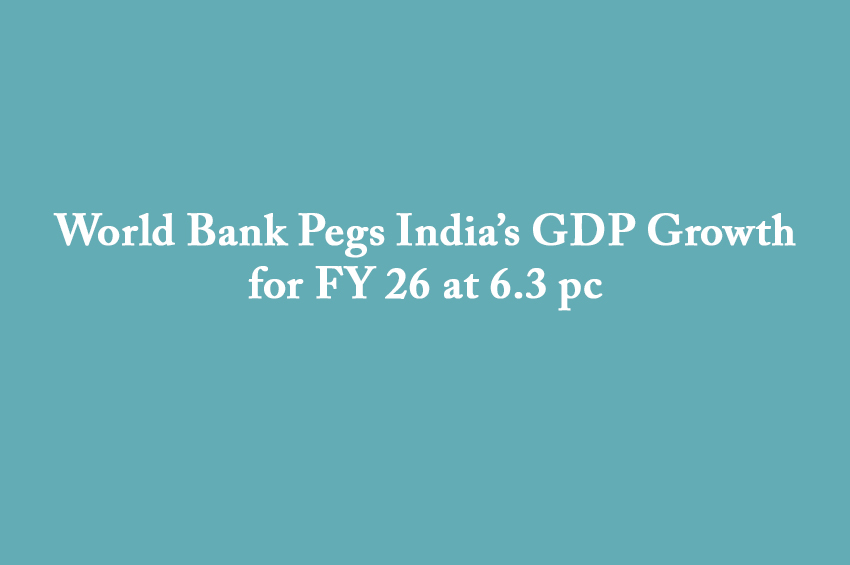Winning Bizness Economic Desk
World Bank Pegs India’s GDP Growth for FY 26 at 6.3 pc
The World Bank (WB) has pegged India’s GDP growth for this fiscal (FY 26) at 6.3 per cent. In January, it had projected the country’s GDP growth for this fiscal at 6.7 per cent but has now trimmed it following dampened exports and investment growth.
Here, an important point to note is that this 0.4 per cent cut in the country’s growth forecast reflects an equivalent trimming in the global growth forecast to 2.3 per cent.
The World Bank’s new forecast for India, included in the June 2025 update of its Global Economic Prospects report released just a few days ago in Washington, is lower than the 6.5 per cent growth for 2025-26 that the Reserve Bank of India (RBI) had predicted in its latest monetary policy announcement on June 6.
“India is projected to maintain the fastest growth rate among the world’s largest economies at 6.3 per cent in FY 25-26,” the report said.
“Nevertheless, the forecast for growth in FY 25-26 has been downgraded by 0.4 percentage points relative to January projections with exports dampened by weaker activity in key trading partners and rising global trade barriers.”
“Investment growth is expected to slow, primarily reflecting a surge in global policy uncertainty,” the report added.
However, the global institution also predicted that growth is expected to increase again in the next two-years (FY 27 and FY 28) to 6.6 per cent a year, on average, partly supported by robust services activity that is likely to enable a revival in export growth.
“Activity has moderated in India—South Asia’s largest economy—largely reflecting a slowdown in industrial production, offsetting steady services activity and the recovery in agriculture output,” the report stated.
With respect to global growth, the World Bank pointed out that heightened trade tensions and policy uncertainty are expected to slow global growth this year to its slowest pace since 2008, not counting outright global recessions.
India’s May Headline Inflation Eases to 2.82 pc
The country’s consumer inflation has eased to a cooler-than-expected 2.82 per cent in May of this year, the Ministry of Statistics and Programme Implementation (MoSPI) said.
The Year-on-Year (YoY) headline inflation hit its lowest level since February 2019, according to a government release.
Food inflation, a crucial metric, hit 0.99 per cent last month (May), well below the 1.78 per cent of the previous month (April).
Vegetables inflation dipped by 13.7 per cent in April, with cereal price growth up by 4.77 per cent in May.
The country’s central bank, the Reserve Bank of India (RBI) has relaxed monetary policy amid easing inflationary pressures.
Most recently, the RBI trimmed its benchmark repo rate by 50 basis points (bps) or 0.50 per cent to 5.50 per cent.
The move underscored policy-makers’ shift toward bolstering economic growth with the Reserve Bank having now cut interest rates for three consecutive meetings since February.
India’s Vegetable Oil Imports Slide for Sixth Straight Month to 11.87-lakh Tonnes in May
India’s vegetable oil imports slid for the sixth consecutive month by 22.36 per cent to 11.87-lakh tonnes in May from a year earlier, industry body the Solvent Extractors Association (SEA) said.
The recent import duty cut would not impact the overall volumes, the industry body said.
Total vegetable oils, comprising both edible and non-edible oils, stood at 15.29-lakh tonnes in the year-ago period.
During the first seven-months of 2024-25 oil year (November-to-October), the total vegetable oil imports moved southward to 78.84-lakh tonnes from 86.78-lakh tonnes in the corresponding period a year earlier.
On May 30, the government cut the basic import duty on palm, soybean and sunflower oils to 10 per cent from 20 per cent, effectively reducing the total import duty from 27.5 per cent to 16.5 per cent.
“This move will not impact the overall volume of edible oil imports and is unlikely to cause any upward pressure on edible oil prices,” the SEA said.
It will discourage imports of refined palmolein and shift demand back to crude palm oil, thereby revitalising the domestic refining sector, it said.
Reduction in duty on crude oil will help reduce domestic prices, benefiting consumers. The industry body has appealed to members to pass on the duty cut benefits to consumers, it added.
As per data from SEA, palm oil imports declined 22.32 per cent to 5.92-lakh tonnes in May from 7.63-lakh tonnes a year ago, with crude palm oil shipments down 5.03 per cent to 5.05-lakh tonnes.
Import of soyabean oil slid southward 23 per cent to 3.98-lakh tonnes while sunflower oil imports plunged 55.30 per cent to 1.83-lakh tonnes.
The share of palm oil decreased to 42 per cent from 58 per cent in the last seven-months while soft oils increased to 57 per cent from 42 per cent.
Here, a point to note is that India, the world’s largest edible oil consumer and importer, had edible oil stocks of 13.33-lakh tonnes as of June 1.
Indonesia and Malaysia are major palm oil suppliers to India while Argentina, Brazil and Russia supply soybean oil. Russia and Ukraine are the main suppliers of sunflower oil.
Continental to Invest Rs 100-cr to Boost Passenger Vehicle Business
Tyre manufacturer Continental said that it plans to invest around Rs 100-crore in the country with a view to push-up production capacity and broaden its product portfolio for passenger vehicles and light trucks.
A company statement said that the investment would support the development of tyres tailored specifically for Indian driving conditions. There would be strong emphasis on performance and quality standards, the statement added.
“With our `in the market, for the market’ approach, we’re aligning our portfolio to reflect the evolving lifestyle needs of Indian drivers—from daily commutes and long-distance travel to changing expectations around comfort, safety and convenience,” said Mr Samir Gupta, Managing Director of Continental Tires India.
The investment, equivalent to around Euro 10.5-million, will be directed towards upgrading Continental’s manufacturing facilities in India and expanding its tyre range for passenger cars and light trucks.
A growing demand for larger-inch and ultra high-performance tyres is anticipated by the company across SUVs, 4x4s and similar vehicle categories. In line with this, Continental also plans to introduce the CrossContact AT2 all-terrain tyre in India later this year.
Continental manufactures passenger and light truck tyres at its Modipuram facility in Meerut, Uttar Pradesh.
Recently, Continental announced a strategic shift in its product focus in the country. The company will now focus exclusively on the Passenger Car and Light Truck Tyre (PLT) segment for future growth.
As a part of this transition, Continental will exit the Truck and Bus Radial Tyre (TBR) segment.
This includes ceasing operations of the dedicated TBR production line at its Modipuram facility.India’s Forex Reserves Rise to USD 697-billion
The country’s foreign exchange reserves increased to USD 696.7-billion for the week ended June 6, the Reserve Bank of India (RBI) said.
The country’s forex kitty added USD 5.2-billion over the previous reporting week, the RBI data showed.
In the previous reporting week, reserves had moved southward by USD 1.2-billion to USD 691.5-billion.
The Reserve Bank of India’s forex holdings have steadily recovered after a steep slide from their peak of USD 700-billion at the end of September.
For the week ended June 6, the Foreign Currency Assets (FCAs)—a major component of the reserves—increased USD 3.5-billion to USD 587.7-billion, according to the RBI data.
In dollar terms, the Foreign Currency Assets include the effects of appreciation or depreciation of non-US units such as the Euro, the Pound and the Yen held in the forex reserves.
Gold reserves moved northward by USD 1.6-billion to USD 85.8-billion during the week.
India ranks as the fourth largest holder of forex reserves, sufficient to cover nearly a year of imports.
The country’s forex holdings are the fourth-largest after China, Japan and Switzerland.


